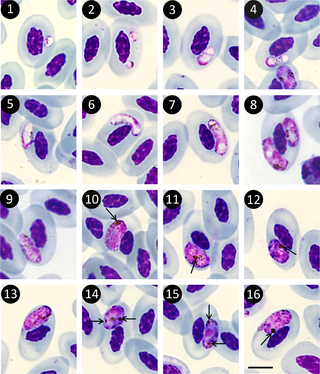
Dasypodidae is a family of mostly extinct genera of armadillos. One genus, Dasypus, is extant, with at least seven living species.

The Plasmodiidae are a family of apicomplexan parasites, including the type genus Plasmodium, which is responsible for malaria. This family was erected in 1903 by Mesnil and is one of the four families in the order Haemospororida.

Dominican amber is amber from the Dominican Republic derived from resin of the extinct tree Hymenaea protera.

The Archamoebae are a group of protists originally thought to have evolved before the acquisition of mitochondria by eukaryotes. They include genera that are internal parasites or commensals of animals. A few species are human pathogens, causing diseases such as amoebic dysentery. The other genera of archamoebae live in freshwater habitats and are unusual among amoebae in possessing flagella. Most have a single nucleus and flagellum, but the giant amoeba Pelomyxa has many of each.

Helenodora is an extinct basal onychophoran or lobopodian genus known from the Carboniferous Carbondale Formation of Illinois. The only known species described is H. inopinata. The ecology of this animal is not well known, but it is thought that it may have lived on land and/or underwater.

Lepicerus is a genus of myxophagan beetles containing three described species in the family Lepiceridae; it is the only extant genus in the family, with another genus, Lepiceratus only known from fossils. Extant species occur in the Neotropics, from Mexico south to Venezuela and Ecuador. Fossils referrable to the genus are known from the early Late Cretaceous of Southeast Asia.

Mermithidae is a family of nematode worms that are endoparasites in arthropods. As early as 1877, Mermithidae was listed as one of nine subdivisions of the Nematoidea. Mermithidae are confused with the horsehair worms of the phylum Nematomorpha that have a similar life history and appearance.

The Haemosporida are an order of intraerythrocytic parasitic alveolates.

Cretaceogekko is an extinct monotypic genus of gecko known from a single partial specimen preserved in Burmese amber from the Cenomanian of Myanmar. The specimen was found in the Hukawng Valley in 2001 and the genus and species were named by E. Nicholas Arnold and George Poinar in 2008. The specimen includes a foot and partial tail. Cretaceogekko is the oldest known gecko, predating the Late Cretaceous gecko Gobekko and the Paleogene gecko Yantarogecko, which has also been preserved in amber.
Haemosporidiasina (Haemosporidia) is a subclass of apicomplexans described by Jacques Euzéby in 1988. The taxon is very similar to Aconoidasida.

Paleoleishmania is an extinct genus of kinetoplastids, a monophyletic group of unicellular parasitic flagellate protozoa. At present it is placed in the family Trypanosomatidae. The genus contains two species, the type species Paleoleishmania proterus and the later described Paleoleishmania neotropicum.

Vetufebrus is an extinct genus of haemospororida in the family Plasmodiidae. At the time of its description the new genus comprised a single species Vetufebrus ovatus known from a single Miocene Dominican amber fossil found on Hispaniola. V. ovatus was vectored by Enischnomyia stegosoma, the first fossil streblid bat fly described from a fossil, and the only member of the subfamily Nycterophiliinae described from Hispaniola. V. ovatus is the first instance of a Streblidae bat fly as a host for a malarial parasite.

Eophasma is a genus of fossil nematodes from the Jurassic of Osteno in Lombardy, Italy. It has only one species, Eophasma jurasicum.
Abathymermis is a genus of nematodes belonging to the family Mermithidae.
Odonatomermis is a genus of nematodes belonging to the family Mermithidae.
Gastromermis is a genus of nematodes belonging to the family Mermithidae.
Eumermis is a genus of nematodes belonging to the family Mermithidae.
Aranimermis is a genus of nematodes belonging to the family Mermithidae.

Mermis is a genus of nematodes belonging to the family Mermithidae.












